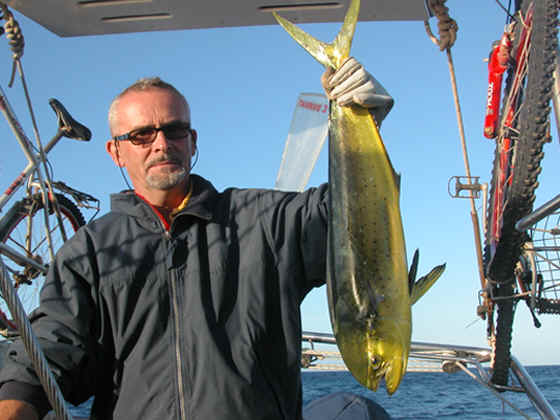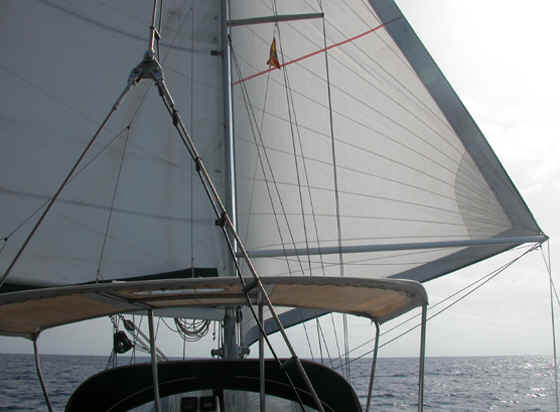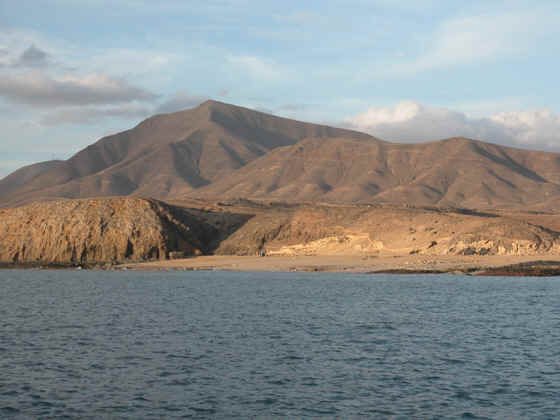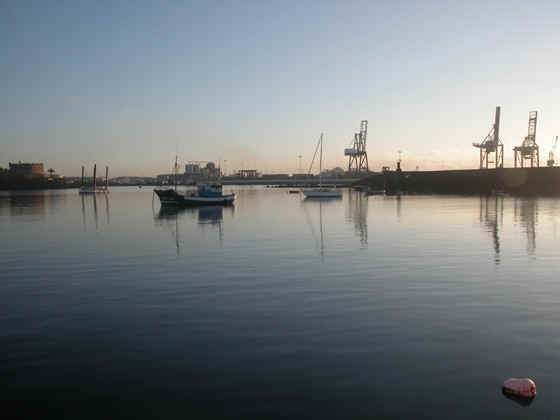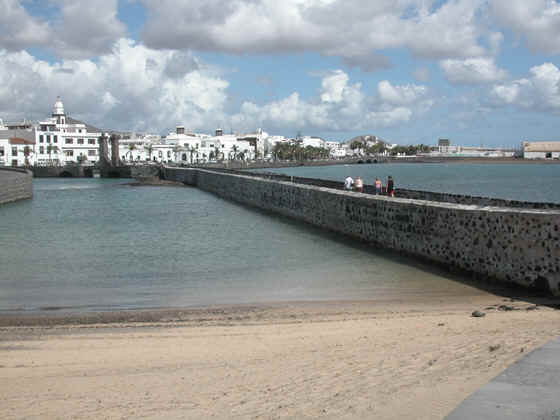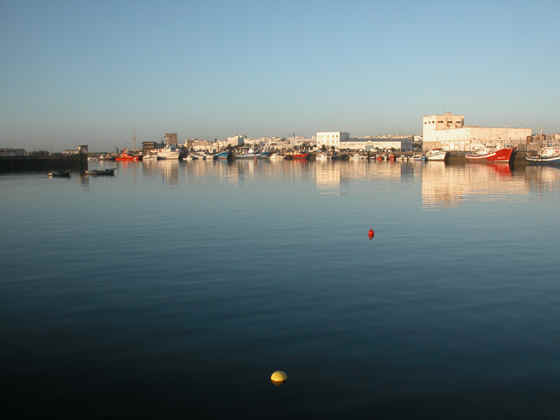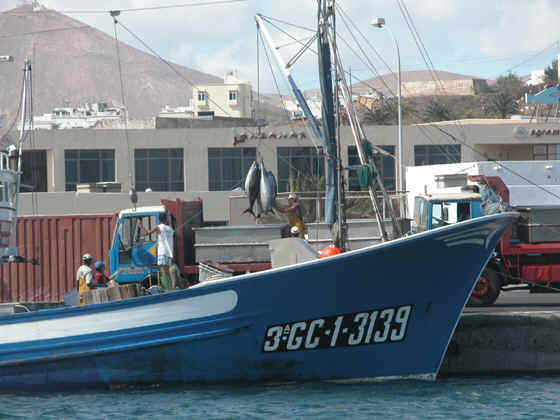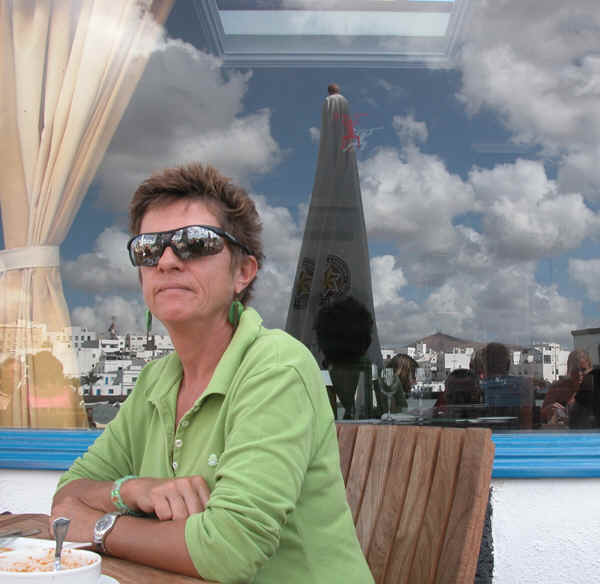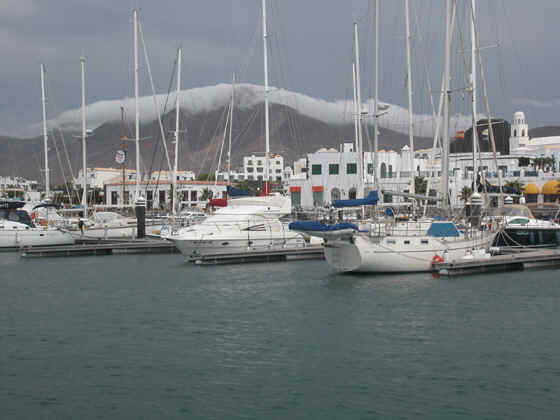
| Well we're on our way to the Canaries. We have good wind and are creaming along at seven + knots through the water most of the time, (we actually max at 8.3 according to the log) and with some helpful current we're doing even better over the ground. But (there always is a but isn't there) the motion is horrible. We've got a big quartering sea behind us, the residue of an old storm further north and we're corkscrew rolling down the back of every wave. We're continually bouncing off hard bits of the boat when moving about and Lindy in particular is black and blue. Fortunately, our newly acquired Decathlon ear-plugs blank out most of the creaking and banging so we're able to get reasonable sleep. | ||
|
|
Then after the first couple of days the sea begins to flatten (the wind and our speed drop a bit of course) and it's a different world. We see dolphins and our first whale and we catch a Dorado. We experiment with a new way of poling out the Genoa - courtesy of Jimmy Cornell- and it works well. We also experiment with our wind-vane steering system. It's fantastic because it's silent and doesn't use any power unlike our hydraulic system, which fails badly on both of these counts. Unfortunately, it only sort of steers the boat. Sometimes it manages a couple of hours at a time, sometimes it lurches off every few minutes and needs almost constant attention. Obviously we need practice. We use it during the day and revert to the more reliable hydraulics while on night watch. |
|
|
And then it's dawn on the 6th day, Lanzarote is in view, it's time to wake Lindy and start disassembling the system of poles and preventers we've been using to sail downwind so that we can begin to manoeuvre towards the harbour. Shame really, we're going so well, it's tempting to leave the sails up and just keep on going. We've sailed 650 miles in 5.5 days and all we have to do is hold this course and in another 4 weeks or so we should run into Brazil. But of course we do the sensible thing, drop the sails and head for the harbour at Caleta de Sebo on Isla Graciosa. This is full and there are boats rafted on the waiting pontoon who have been there for 4 days! So, a little later we drop anchor off the slightly windswept Playa Francesa along with about 20 other boats. |
||
|
|
We stayed for three nights, then with a
southerly gale forecast hauled anchor and we poked our nose into Caleta del
Sebo for a second time. Still full - actually there was space to lie
alongside another British yacht, but they refused to let us - pointing to
an allegedly "broken cleat" which looked perfectly OK from where
we were standing!
No point in arguing, and as we wouldn't have wanted them as neighbours anyway we headed round the top of Lanzarote to the harbour of Puerto De Naos at the capital Arrecife. Naos is a working comercial and fishing harbour, it's not pretty, but it's a great anchorage, very sheltered and free. We stayed for 10 days. Places like Naos are great nautical melting pots. In the inner harbour, amongst all the local boats on permanent moorings we met Bryan. We're not sure how long he'd been there, but as he'd sat out the 2005 hurricane there it must have been some time. He had 9 anchors out and had brought the boat there from the Caribbean for some tender loving care. Even with the rosiest coloured spectacles we weren't able to see any sign of TLC, or even any sails. Hard to see how he'll ever leave. We also met Wendy and Ray on Tigress. They hadn't been there as long as Bryan, just a few months. They had in that time completely re-decked the boat which involved carrying sheets of plywood from the wood-yard to the harbour balanced on their bikes, then to the boat, balanced on the dingy, before being cut to shape and glassed into the hull. When we met them they we're just about there, and by now should have left! |
|
|
Places like Naos are also great places to get things done. The chandlers and workshops are more focused on the fishing fleet than yachts, but as long as you're not looking for Kevlar sails or this seasons Henry Lloyd jacket, you can find most things. We took the opportunity to strengthen our new anchor. The other bits would wait. Spain and particularly the Canaries (because of their proximity to the African coast) have a huge problem with illegal immigration. Small open fishing boats, which to avoid detection by the authorities, have often been built inland and then carried for miles across the desert, are launched from the coasts of countries like Mauritania, heading for the promised land - in this case Lanzarote. They are generally overloaded, with minimal fuel or water and they are heading against the prevailing winds and currents. Not surprisingly, many of them don't make it and of those that don't the lucky ones are brought in by the life boats or the Guardia to begin the lengthy battle against repatriation. While we were in Naos we watched the Salvamiento Maritimo bring in one of these refugee boats. It was about half the length of Samarang and was being towed behind the life boat. There were about a dozen dejected Africans sitting on the stern of the lifeboat wrapped in blankets - it must have been crowded! We hadn't "seen nuthin' yet". Once the life boat berthed about another 30 were brought out from below decks and escorted to the waiting ambulances. Incomprehensible - remember that southerly gale we mentioned!
|
||
|
|
|
|
Another - and slightly happier - unloading we watched was from the tuna fishing boats. These are about 60 feet long with a crew of around a dozen and they fish for tuna using rod & line. Forge the images of all the sophisticated gear that you see in fishing shops. Rod & line is bamboo pole, short length of steel tracer and big hook with small fish on it - and that's it. One of these boats fills two lorries with tuna. Mostly over a meter long and some bigger than a man! How long does it take for a tuna to grow that big? How many tuna are there in the sea? It is hard to make the mental leap from watching this to the tins we see on the supermarket shelf. After a week and a half the sights and smells of Naos and the too touristy Arrecife (though again we "ain't seen nuthin' yet) start to wear a bit thin and we head off south down Lanzarote. |
|
|
|
|
Our target is Puerto Calero designed by Cesar Manrique - all brass bollards, polished stainless and no hanging out your washing! Very smart and worth a look, but only for a day or two or Lindy would go into a confusional state from having water/power but not being able to switch on the machine. In the event, the wind decides otherwise and we skip Calero and continue round the headland to Rubicon, another smart custom designed marina. This also has a "No Washing" rule, but here it is not enforced. In Rubicon there are designer shops and smart bars, but no chandlers. However it's nicely done, and a pleasant if slightly soulless place to spend some time. It is also a bit off-season so we are able to snap up some discount Italian swimware.
|
|
|
We walk about a mile round the coast to Playa Blanca where the nearest supermarket is located. Playa Blanca is now a slightly down-market tourist development aimed at mainly British tourists - All day full English breakfasts, roast beef and two veg, and a lot of pink people. Surely this is the worst of tourism, but again " we ain't seen nuthin' yet"! Back in the marina we have several nice neighbours, most of whom, like us, are passing through. One evening which sticks in the mind is a visit to Bernt and Gerda to swap music (swapping/copying music, DVDs, books, software is a permanent nautical pastime). Bernt, it turns out, has something upwards of 300GB of music! To put that in perspective our 200+ CDs occupy not much more than 10GB. He's got the equivalent of thousands of CDs. He copies everything he can get from anyone he meets, just as he now takes all of ours. I'm pretty sure he's never even tried to listen to most of it. I wipe a spare hard drive and take everything of his that I vaguely recognise or sounds interesting (about 50GB). Over the next few months much sorting is needed , and the high proportion of damaged and unusable files confirms my suspicion that he hoards rather than listens. I'm reminded of an ex-boss of mine back in the 70s - Les Vranch - whose obsession is copying the entire Bristol Central Library's record collection, two LPs per week, onto cassettes. He too has never listened to them, "but I will when I retire". I never did ask Bernt if he knew Les Vranch. It is now November and time to move on to what will be our base for the next few months. We want to stay until the spring. This is because when we leave the Canaries we plan to head south to the Cape Verdes and from there cross to Brazil. The maximum length of visa that we will be allowed in Brazil is 180 days. When we leave there, we will probably head north to the Caribbean and our arrival there needs to be after the end of next years hurricane season. This is our first 'big' plan and we will try and stick to it...... Since we are to be at our 'base' for some months we really want to be in a proper town which seems to give us only two options. The first of these is the marina at Las Palmas de Gran Canaria which we know will be full to bursting with yachts who will be leaving on the ARC (almost certainly including the boat with the "broken" cleat). The only other option is Marina del Atlantico at Santa Cruz de Tenerife, which we are worried might also get full. So we've booked there for 3 months and paid a 50% deposit. But that's another story!
|
||
